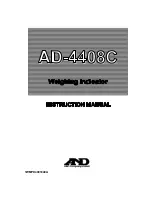
•
The signal BLKV should appear with almost no time delay.
•
The signals BLKZ and 3PH should not appear on the IED.
•
Only the distance protection function can trip.
•
Undervoltage-dependent functions must not trip.
3.
Disconnect the dc voltage from the 89b binary input terminal.
4.
Connect the nominal dc voltage to the MCBOP binary input.
•
The BLKVand BLKZ signals should appear without any time delay.
•
All undervoltage-dependent functions must be blocked.
5.
Disconnect the dc voltage from the MCBOP binary input terminal.
6.
Disconnect one of the phase voltages and observe the logical output signals on the
binary outputs of the IED.
BLKV and BLKZ signals should appear simultaneously wether the BLKV and
BLKZ reset depends on the setting
SealIn
“on” or “off”. If “on” no reset, if “off”
reset.
7.
After more than 5 seconds disconnect the remaining two-phase voltages and all three
currents.
•
There should be no change in the high status of the output signals BLKV and
BLKZ.
•
The signal 3PH will appear.
8.
Establish normal voltage and current operating conditions simultaneously and
observe the corresponding output signals.
They should change to logical 0 as follows:
•
Signal 3PH after about 25ms
•
Signal BLKV after about 50ms
•
Signal BLKZ after about 200ms
11.8.2.2
Measuring the trip value for the negative sequence function
Measure the trip value for the negative sequence function, if included in the IED.
1.
Simulate normal operating conditions with the three-phase currents in phase with
their corresponding phase voltages and with all of them equal to their rated values.
2.
Slowly decrease the measured voltage in one phase until the BLKV signal appears.
3.
Record the measured voltage and calculate the corresponding negative-sequence
voltage according to the equation (observe that the voltages in the equation are
phasors):
Section 11
1MRK 511 366-UUS -
Testing functionality by secondary injection
150
Commissioning manual
Summary of Contents for RES670 2.1
Page 1: ...Relion 670 series Phasor measurement unit RES670 2 1 ANSI Commissioning manual ...
Page 2: ......
Page 14: ...8 ...
Page 56: ...50 ...
Page 60: ...54 ...
Page 68: ...62 ...
Page 86: ...80 ...
Page 102: ...96 ...
Page 178: ...172 ...
Page 200: ...194 ...
Page 201: ...195 ...
















































